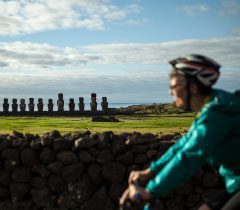Atacama
Desert & Altiplano, Chile
The Areas we explore
Our explorations in Atacama are divided into five different altitude zones, each with a set of unique geographic, cultural and biospheric characteristics. All explorations have been designed in order to gradually unveil the territory’s essence – either on foot, bicycle or from within the Explora observatory. We recommend starting with explorations in the Salt Flat Basin zone where our lodge is located, continuing with explorations in the Intermediate Ravine zone, the Altiplano zone and, finally, the Mountain zone.
Cuenca del salar
Geometric and seemingly infinite, the Atacama salt flat abruptly interrupts the desert’s chromatic continuum. The crunch of salt under every footstep is swept into silence by the wind, and all that’s left is to go deeper into the territory around you.
The lowest part of this area corresponds to the Atacama Salt Flat (2350 m.a.s.l.) itself, an endorheic basin that once accumulated the waters and sediments from volcanoes and mountains over millions of years. Today it hosts a complex ecosystem, including half of the world’s flamingo species. Also within this Exploration zone, the Salt Mountain range rises to the west of the salt flat in a geological spectacle, as crusts of sediments crown the rugged mountains that frame the desert. Finally, we recommend exploring the Oasis of San Pedro, which stands as a beacon of life and local traditions kept alive by its people
Quebradas Intermedias
As if sliced off from the desert’s mantle, the ravines in this zone were created over millions of years by the forces of water and wind. Plunging into the abyss, they are sculptures that only time could shape.
Numerous ravines connect the Altiplano and Salt Flat Basin zones, crisscrossing the ascent while volcanic stonewalls and brooks lined with wild grass species modestly irrigate the surrounding land, making room for medicinal plants and flowers which have been used by local shepherding communities for centuries. The Domeyko Mountain Range, located in this zone, hosts wildlife and cultural heritage alike, with guanacos and ancient petroglyphs doting certain hillsides. The ravines offer a cradle for life to flourish in, as is the case of the Puritama Natural Reserve, where a series of hot springs irrigate and sustain a series of ecosystems within.
Altiplano
The Altiplano exists up there, somewhere between the mountains and the sky. Within, a whole new world silently awaits the intrepid explorers that venture its way. For us, this is a territory that words simply fall short of.
The Altiplano zone –or Puna as it is known locally– stretches between 3800 and 4300 m.a.s.l. It is an elevated plateau, crowned by imposing mountains, volcanoes and geysers. Lack of oxygen, intense sunlight and extreme temperatures keep this unique territory safe, calling only those who are drawn to unusual beauty.
Explorations in Altiplano >Cielo
Atacama’s night skies are a constant spectacle. When night falls, the sky becomes alive with the infinite powder of the Milky Way or Celestial River, as it is known in Atacama. Star-gazing has been a pastime of humanity since the dawn of time, as our forefathers often looked to the skies for divine answers. Atacama’s night skies’ sheer definition allows gazers to draw their own constellations and meaning from beyond our planet and even our galaxy. At the center of the Milky Way lies the Yakana or constellation of the Llama, seen breastfeeding its newborn calf. To its right are the Partridge, the Frog and the Serpent constellations, which guide the Andean shepherds and farmers, protecting them seasonal floods.
Explorations in Cielo >Montaña
These colossal massifs not only hoard minerals, but also encompass cultural expressions of people past and present. Axes of mystery, Atacama’s mountains frame its territory, remaining vigilant of all whom explore it.
The best views of Atacama can be found by reaching the peaks of the Licancabur Volcano along with the Kimal, Toco, Láscar, Corona, Soquete, Sairecabur and Colorado mountains – summits that scrape the skies at over 5000 m.a.s.l. Though spectacular, this altitude level requires physical stamina and preparation, and is therefore not for the faint of heart. The rewards, however, are worth the patience and dedication: a unique encounter with the world from above

